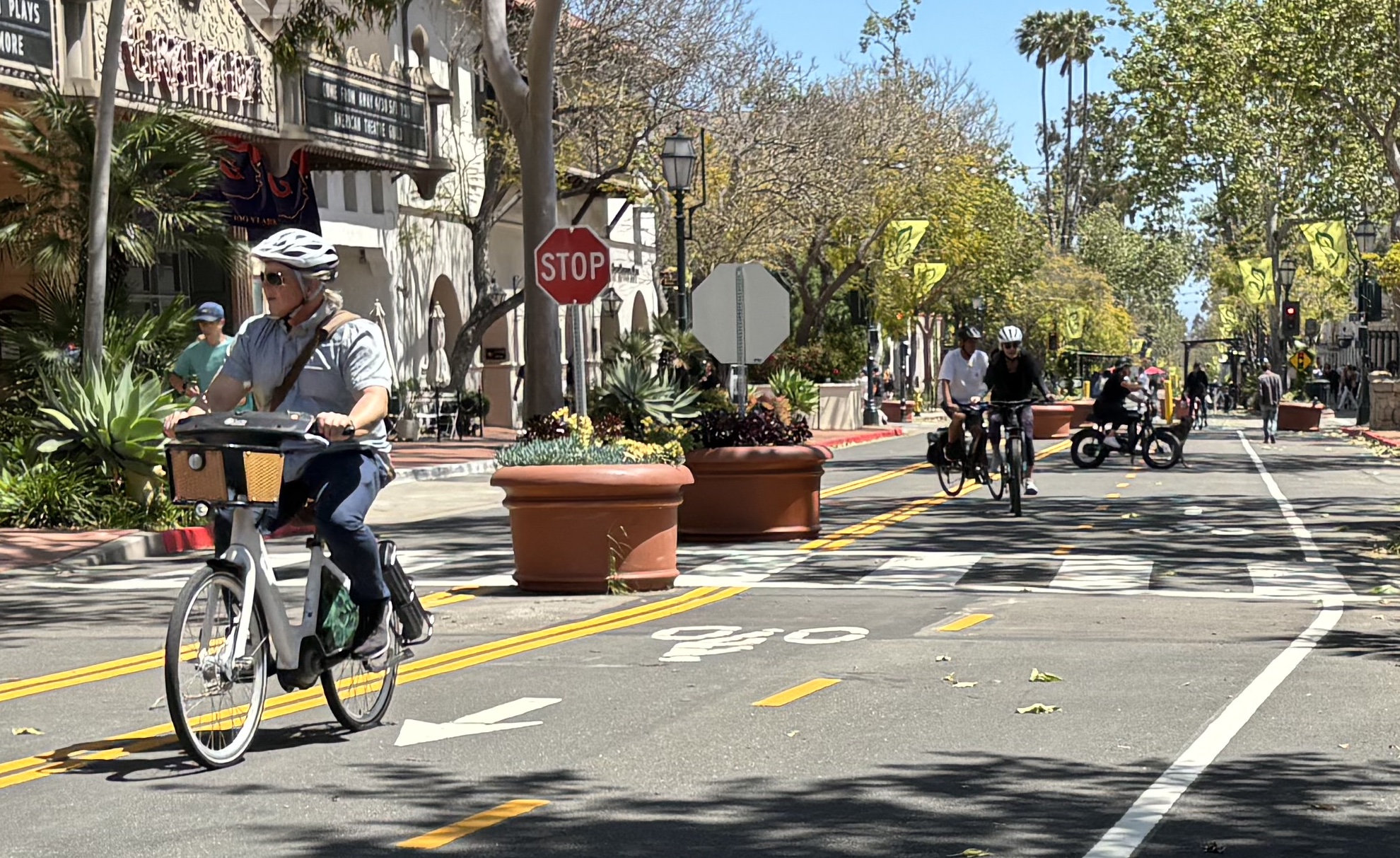E-bikes Need More and Bigger Bike Lanes
Cities Need to Build Infrastructure for the Future

Earlier this month, Santa Barbara’s City Council released a climate action plan that set the goal of being climate neutral by 2035. In the U.S., 30 percent of carbon emissions are from transportation. To become a climate-neutral city, we will need sustainable transportation options.
Santa Barbarians have already embraced a flexible, affordable, and sustainable form of transportation — the e-bike. It makes sense. Santa Barbara’s geography is perfect for e-biking. We have fair weather year-round, low density, and lots of hills. Additionally, e-bikes have been shown to increase the distance people will travel (from about 3 to 6 miles) and increase the number of women riders. Recent data collected by my team at UC Santa Barbara shows that in Santa Barbara and Goleta, e-bikes account for nearly 50 percent of all bikes.
Not everyone is delighted by the arrival of e-bikes on our streets. E-bikes are disrupting transportation in Santa Barbara. In part, because e-biking is happening on roads and paths that were not designed for their use. Consequently, people are concerned about safety, especially the safety of our teenagers.
The evidence on how to incorporate e-biking safely on our roads is still being compiled. So how do we set policy to improve e-bike safety today?
The answer is to build more and bigger bike lanes.
All evidence shows that bicyclist safety requires separation from motor vehicles. When there is a strong barrier between vehicles and bikes, the odds of crashing are one-tenth that of biking near cars.
Adding e-bikes to bike lanes has some of the same challenges as having fast and slow bicyclists sharing the same space. The behavior and speed of a spandex-clad bicyclist aiming to set a personal record is not the same as a typical commuter or a family riding with young children. Especially for heavily used bike lanes, fast bicyclists maneuvering around slower bicyclists can cause conflict and crashes. Interestingly, similar safety issues also emerge when walkers and bicyclists share the same space.
We are still conducting research that will provide decision makers with evidence on the best way to integrate e-bikes safely into our transportation network. However, we do have a wealth of research that has shown that different modes of transportation tend to be safest when separated from other modes. Vehicle drivers, bicyclists, and pedestrians all benefit from having their own space. Even mixing pedestrians and bicycles on multi-use paths has been shown to increase risk of crashes, and the recommendation is to create more space and designate use areas.
More and bigger bike lanes will help us build a transportation system that is future proofed. It will be able to handle increased demands and have enough space for multiple types of transportation that will be needed to meet climate goals.
Even the best bike infrastructure will not completely stop the risky behaviors of teen e-bikers. I have seen the same things you have — kids e-biking on phones, no helmets, and multiple people on one bike. But, some of the most dangerous behavior, such as sidewalk riding, is the result of not having appropriate safe space for e-biking, and separating e-bikes from cars will reduce the consequence associated with a lot of risky behavior we commonly see on e-bikes.
To be sure, the carbon benefits of e-bikes cannot be accomplished with other electric vehicles (EVs) alone. The carbon required to make an electric vehicle, cost of purchase, and impact on the grid means EVs cannot be the only solution. E-bikes are less expensive, more sustainable to build, and run on much less energy. E-bikes and EVs complement one another, and many forms of transportation should be supported if we hope to make carbon neutrality real.
Cities need to build infrastructure for the future. More and bigger bike lanes will future proof our transportation network, supporting transportation changes needed to reach climate neutrality. E-bikes are disruption, but the tension brought by disruption is an opportunity for change and innovation. Santa Barbara can be a national leader in how to build a carbon-neutral city and transportation system, which must include safe e-biking. Imagine if we succeed! Fewer cars, less air pollution, reduced carbon emissions, and more freedom to move safely and sustainably through our city.
Trisalyn Nelson is the Dangermond Chair of Geography and a Public Voices Fellow of The OpEd Project and the University of California, Santa Barbara. In 2014, Prof. Nelson founded BikeMaps.org website for crowdsourcing bicycle safety data globally.
